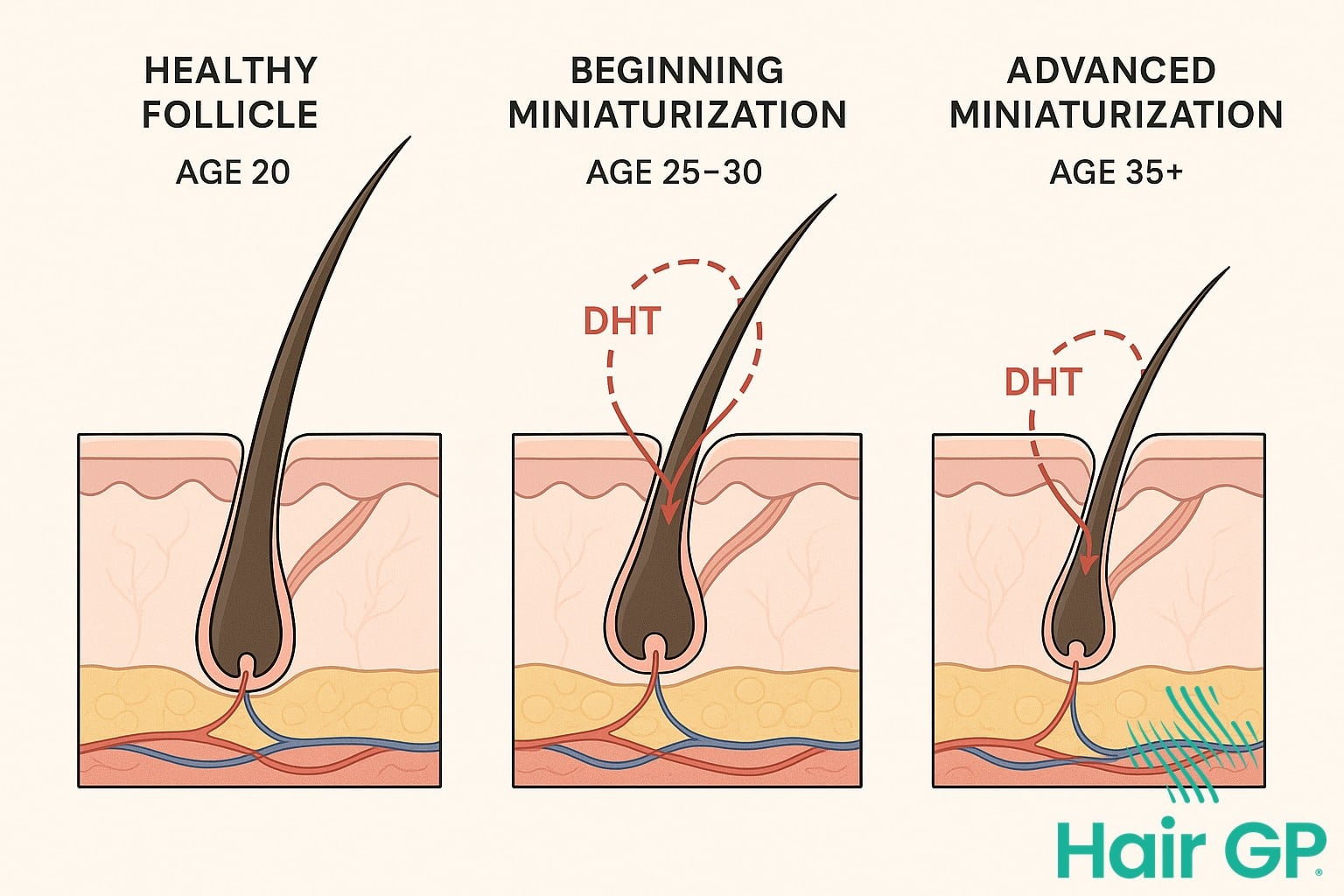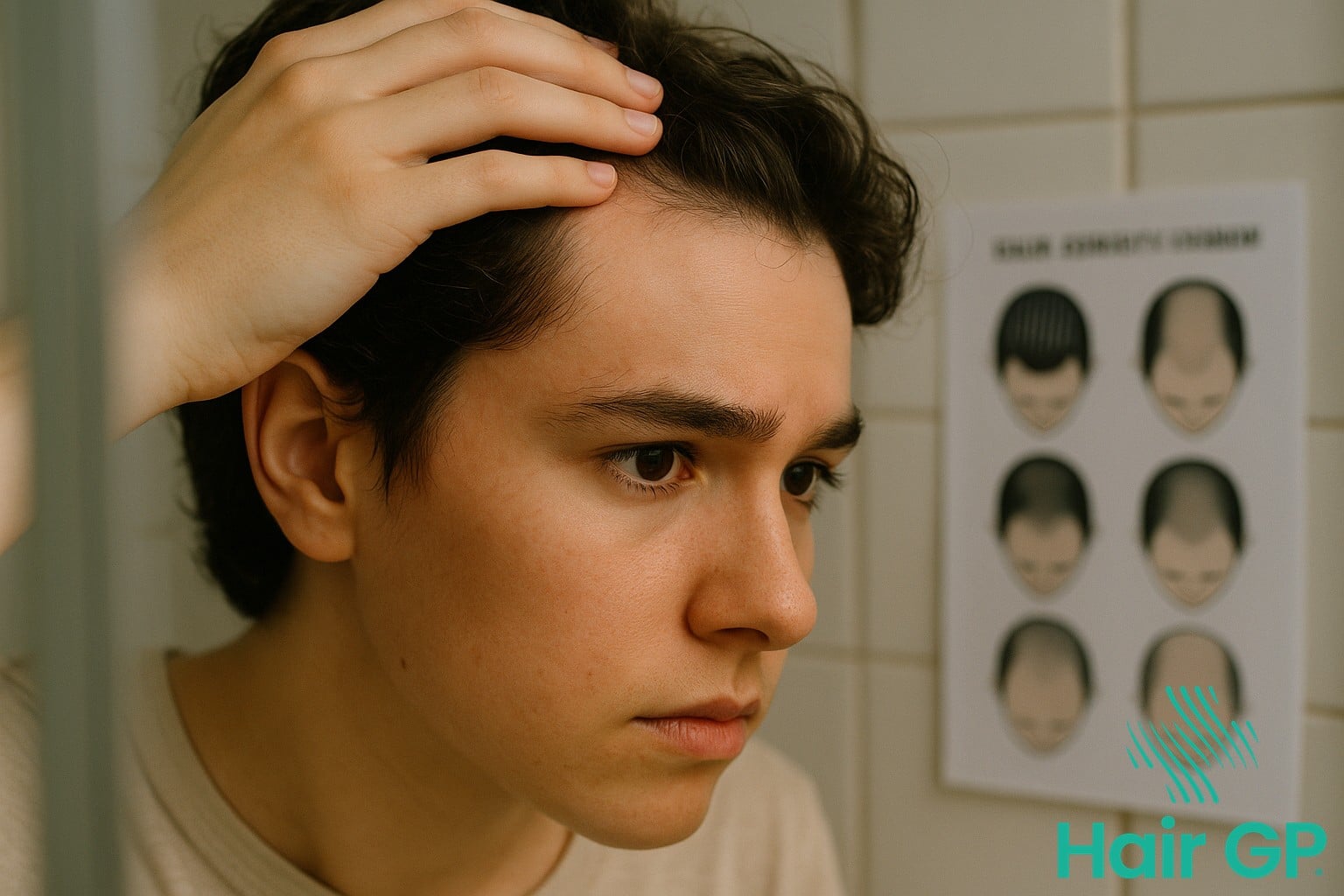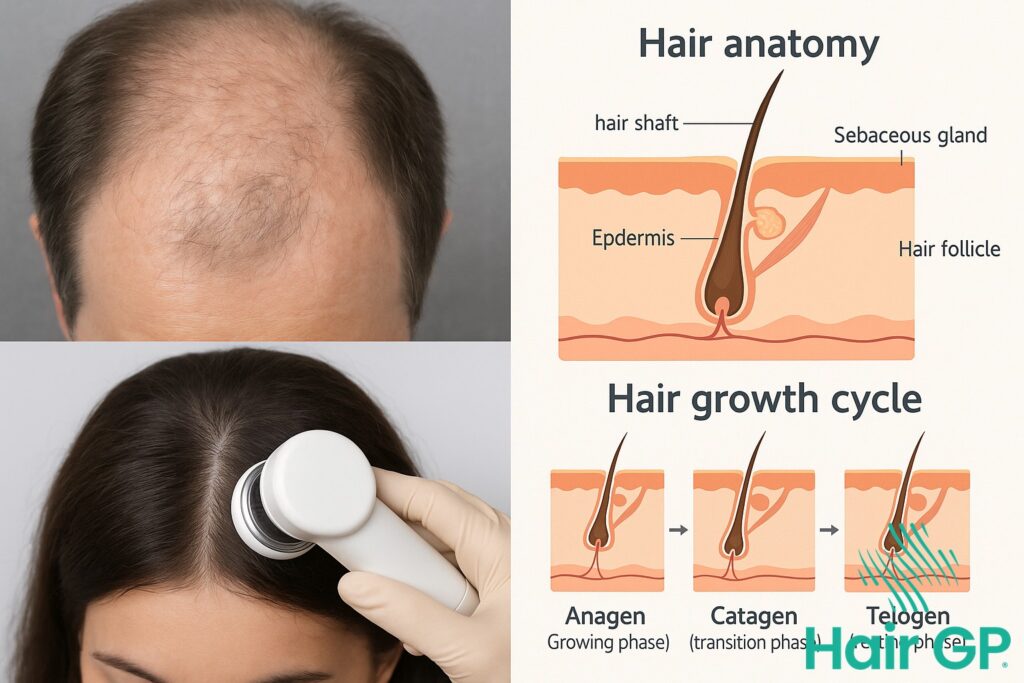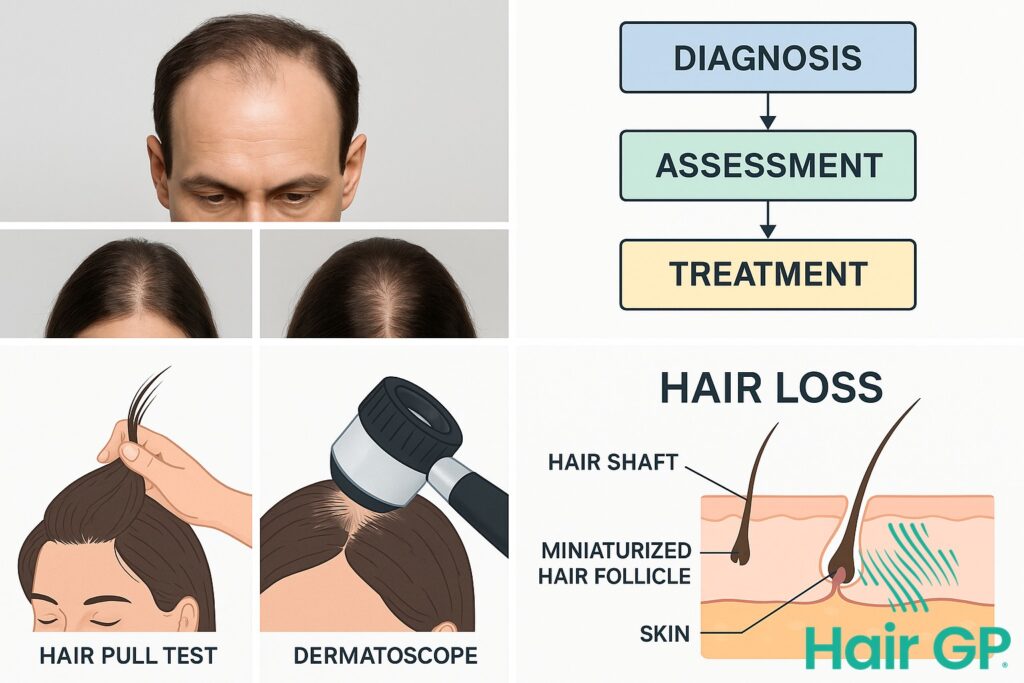Introduction
Discovering the first signs of thinning hair in your twenties can feel overwhelming, but this pivotal decade actually represents your greatest opportunity for successful hair loss prevention. The early intervention advantage cannot be overstated—taking action now, when follicles are still responsive and damage minimal, can preserve your hair health for decades to come.
Hair loss rarely happens overnight. It’s a gradual process that often begins subtly in early adulthood, influenced by genetic predisposition, hormonal changes, and lifestyle factors. Whilst genetics may load the gun, environmental and behavioural choices pull the trigger. The good news? Your twenties offer the optimal window for addressing hair loss before it becomes visually apparent or structurally irreversible.
This comprehensive guide explores the science behind why early intervention works so effectively, helping you understand how hair follicles change over time and why catching these changes early makes all the difference. You’ll discover how to recognise subtle warning signs that precede visible thinning, explore medically-proven treatments that work best when started young, and learn which lifestyle modifications genuinely impact follicle health.
We’ll examine the crucial role nutrition plays in maintaining strong hair, provide frameworks for creating personalised prevention strategies, and clarify when professional consultation becomes necessary. Whether you’re noticing early changes or simply want to be proactive about your hair health, this evidence-based approach empowers you to take control of your hair’s future whilst you have the greatest chance of success.
Key Takeaways – TL/DR
- Starting hair loss prevention in your 20s can preserve up to 90% more hair density compared to waiting until visible thinning occurs
- Early intervention treatments are 3-5 times more effective than restoration attempts after significant loss
- Genetic predisposition doesn’t guarantee hair loss – proactive measures can delay or prevent progression
- Combination approaches targeting lifestyle, nutrition, and medical interventions yield the best long-term results
Understanding Hair Loss in Your 20s: Why Early Detection Matters
Your twenties mark a crucial biological crossroads for hair health, where genetic predispositions and hormonal changes converge to initiate the earliest stages of androgenetic alopecia. Understanding these underlying mechanisms empowers you to recognise subtle changes early, when interventions prove most effective in preserving hair density for years ahead.
The Science Behind Early Hair Follicle Changes
The hair growth cycle undergoes subtle but significant alterations during early adulthood, particularly as sensitivity to dihydrotestosterone (DHT) increases following puberty. Research shows that approximately 25% of men experience some degree of hair loss before age 21, with this figure rising to 66% by age 35 [1]. This gradual process begins with the miniaturisation of hair follicles, where DHT binds to androgen receptors, progressively shortening the growth phase and producing thinner, weaker strands.
What makes early detection challenging is that initial follicular changes remain invisible to the naked eye. Studies demonstrate that individuals typically lose 50% of hair density before thinning becomes noticeable [2]. During your twenties, affected follicles gradually produce progressively finer hairs with each successive cycle, eventually yielding only vellus hairs before ceasing production entirely.
Male vs Female Pattern Hair Loss in Young Adults
Male pattern baldness typically manifests through recession at the temples and crown thinning, following predictable patterns that can begin as early as late teens. Female pattern baldness, conversely, presents as diffuse thinning across the crown whilst preserving the frontal hairline, often becoming apparent later in the twenties.
Hormonal influences vary significantly between genders, with men experiencing direct DHT-mediated follicle damage, whilst women face complex interactions between androgens, oestrogen, and other hormonal factors. These differences influence treatment responses, with men generally showing more predictable results from DHT-blocking interventions, whilst women often require multifaceted approaches addressing various hormonal imbalances.

Recognizing Early Warning Signs Before Visible Hair Loss
Spotting the first signs of hair loss requires understanding subtle changes that occur long before visible thinning becomes apparent. By learning to recognise these early signs and differentiating them from normal hair behaviour, you can seek early diagnosis and intervention when treatment options are most effective.
Daily Shedding vs Excessive Hair Loss
Understanding the difference between normal and excessive shedding forms the foundation of early detection. Whilst losing 50-100 hairs daily is completely normal, sudden increased hair shedding beyond this range warrants attention. You might notice more strands accumulating on your pillow, in the shower drain, or when running fingers through your hair. Seasonal variations, particularly in autumn, can temporarily increase shedding without indicating permanent loss. However, consistent excessive shedding lasting more than six weeks often signals an underlying issue requiring professional evaluation.
Family History and Genetic Risk Assessment
Your genetic blueprint provides crucial insights into hair loss risk. Both maternal and paternal genetics contribute to pattern baldness, debunking the myth that only your mother’s side matters. Observe the age when relatives first noticed thinning or a receding hairline—if multiple family members experienced hair loss before 30, your risk increases significantly. Modern genetic testing can now identify specific markers associated with androgenetic alopecia, offering personalised risk assessment. However, genetics isn’t destiny; understanding your predisposition simply enables proactive monitoring and earlier intervention when changes first appear.

Medical Treatments: Proven Early Intervention Options
Medical interventions for early-stage hair loss treatment demonstrate significantly improved efficacy when initiated before substantial follicular miniaturisation occurs. Evidence-based approaches combining FDA-approved topical and oral medications with emerging therapies achieve optimal outcomes through complementary mechanisms targeting different aspects of the hair growth cycle.
Minoxidil and Finasteride: The Gold Standard Combination
The synergistic application of minoxidil and finasteride represents the most thoroughly researched hair loss treatment protocol. Minoxidil functions as a vasodilator, enhancing follicular blood flow and extending the anagen phase, whilst finasteride inhibits 5-alpha reductase, reducing dihydrotestosterone levels by approximately 70% [3]. Clinical studies demonstrate that combination therapy improves hair density outcomes by 35-40% compared to monotherapy approaches [4].
Early intervention with this dual approach prevents further miniaturisation whilst promoting regrowth of recently affected follicles. Side effect management strategies include gradual dose escalation for minoxidil to minimise initial shedding, and monitoring sexual function parameters with finasteride, though adverse effects occur in less than 2% of patients when properly administered .
Advanced Therapies: PRP and Laser Treatment
Platelet rich plasma PRP therapy leverages autologous growth factors including PDGF and VEGF to stimulate dormant follicles. Recent meta-analyses confirm significant improvements in hair density following three to four monthly sessions, with effects particularly pronounced when initiated during early thinning stages [5].
Low level laser therapy employs photobiomodulation at 650-670nm wavelengths to enhance mitochondrial function and improve follicular circulation. Clinical trials demonstrate 25-35% increased hair counts after 26 weeks of treatment [6]. Both modalities function optimally as adjunct treatments alongside pharmaceutical interventions, rather than standalone solutions. The combination of conventional medications with these advanced therapies creates a comprehensive approach addressing multiple pathophysiological mechanisms simultaneously.

Lifestyle Factors That Promote Hair Health in Your 20s
Maintaining healthy hair in your 20s extends far beyond topical treatments, as lifestyle factors play a fundamental role in promoting robust hair growth and preventing premature loss. A balanced diet rich in protein, iron, zinc, and B vitamins provides the essential building blocks your hair follicles need to produce strong, resilient strands. Incorporating foods like eggs, leafy greens, nuts, and fatty fish ensures your hair receives optimal nourishment from within.
Regular exercise significantly benefits hair health by improving blood circulation to the scalp, delivering vital nutrients and oxygen to hair follicles. Activities like yoga, jogging, or swimming for 30 minutes daily can enhance scalp circulation whilst simultaneously supporting stress management. Speaking of stress, chronic tension triggers cortisol release, which can disrupt hair growth cycles and accelerate shedding.
Implementing stress reducing techniques such as meditation, deep breathing exercises, or progressive muscle relaxation can help maintain hormonal balance crucial for hair retention. Quality sleep, typically 7-9 hours nightly, allows your body to repair and regenerate hair follicles. Creating a consistent sleep schedule and limiting screen time before bed optimises your body’s natural recovery processes, supporting healthier hair growth throughout your 20s and beyond.

Nutrition and Supplements for Optimal Hair Growth
Optimal hair growth depends fundamentally on proper nutrition, as hair follicles require specific essential nutrients to maintain their rapid metabolic activity. Nutritional deficiencies can trigger telogen effluvium and accelerate pattern hair loss, particularly when protein, iron, or B-vitamins are inadequate [7].
Essential Vitamins and Minerals for Hair Follicles
Hair follicles demand a complex array of vitamins and minerals for optimal function. Iron deficiency, affecting 30% of premenopausal women, disrupts DNA synthesis in rapidly dividing follicle cells, whilst zinc regulates hormone levels and protein synthesis essential for hair structure. Biotin, though widely marketed, primarily benefits those with documented deficiency [5]. Vitamin D plays a crucial role in hair follicle cycling, with receptors present throughout the follicle structure—deficiency correlates with alopecia areata and telogen effluvium [8]. Omega-3 fatty acids from fish oil provide anti-inflammatory benefits that protect follicles from damage. A balanced diet rich in lean proteins, colourful vegetables, and whole grains typically supplies adequate nutrients without supplementation. However, vegetarians may require additional iron and B12, whilst those with restricted sun exposure often benefit from vitamin D supplementation to support healthy hair growth cycles.
Creating Your Personalized Prevention Strategy
Developing effective personalized treatment plans requires careful assessment of individual risk factors, lifestyle circumstances, and realistic outcome expectations. Success in hair loss prevention relies on selecting appropriate treatment options whilst establishing consistent preventive measures tailored to your specific needs and goals.
Monitoring Progress and Adjusting Your Approach
Systematic photo documentation using standardised lighting and angles provides objective assessment beyond subjective perception. Capture images monthly from crown, temporal, and profile views to track subtle improvements that emerge gradually with early treatment implementation.
Success metrics extend beyond density measurements to include reduced shedding rates, improved hair texture, and enhanced scalp health. Most individuals notice decreased hair fall within 8-12 weeks, whilst visible regrowth typically requires 4-6 months of consistent therapy.
Regular consultations with your healthcare provider enable timely adjustments when initial responses prove suboptimal. Modifying dosages, incorporating adjunctive therapies, or addressing underlying conditions optimises outcomes whilst managing potential side effects effectively.
The long term benefits of personalised prevention strategies compound over time, preserving existing follicles whilst potentially reversing recent miniaturisation when initiated promptly.
Professional Resources and When to Seek Expert Help
Whilst many hair concerns can be addressed through preventive measures, certain situations warrant professional evaluation from a qualified hair specialist Doctor. Seeking expert guidance becomes essential when you notice sudden or dramatic hair loss, persistent scalp irritation, unusual hair texture changes, or when over-the-counter treatments fail to produce results after three months. These specialists possess the expertise to differentiate between various hair loss conditions and develop targeted treatment strategies specific to your needs.
Professional evaluation typically involves comprehensive diagnostic tools to ensure an accurate diagnosis. Blood tests can reveal underlying nutritional deficiencies, hormonal imbalances, or thyroid disorders affecting hair health. In some cases, scalp biopsies may be performed to examine hair follicles at a microscopic level, particularly when autoimmune conditions or scarring alopecias are suspected. These diagnostic procedures provide crucial insights that guide treatment decisions.
To maximise your consultation effectiveness, document your symptoms with photographs, maintain a list of current medications and supplements, and prepare questions about treatment options. When selecting a provider, verify their credentials, seek referrals from your GP, and ensure they specialise in hair and scalp conditions rather than general dermatology.
Conclusion
The evidence is unequivocal: early intervention in your twenties represents the most powerful strategy for maintaining optimal hair health throughout your lifetime. By recognising subtle changes and implementing prevention measures before significant loss occurs, you’re positioning yourself for dramatically superior outcomes compared to attempting hair restoration after extensive damage has taken place.
The long term benefits of proactive treatment extend far beyond simply preserving existing follicles. Early adopters experience enhanced treatment responsiveness, reduced progression rates, and maintenance of natural hair patterns that become increasingly difficult to restore with age. Your future self will thank you for the investment made today in comprehensive hair care protocols.
Success lies in embracing a multifaceted approach tailored to your specific needs and genetic predisposition. Whether combining minoxidil with dermarolling, incorporating lifestyle modifications alongside medical treatments, or exploring advanced therapies at the first signs of thinning, the key is consistent, informed action. Don’t wait for visible recession or thinning to motivate change – the optimal window for prevention is now, whilst follicles remain responsive and salvageable. Take control of your hair’s trajectory today by consulting qualified professionals who can develop personalised strategies aligned with your unique circumstances and goals.
Frequently Asked Questions
If you have a family history of hair loss, starting preventive measures in your early 20s is ideal. Even without genetic predisposition, establishing good hair care habits and monitoring for early signs by age 25 can help maintain hair health long-term.
Stress-induced hair loss (telogen effluvium) is typically temporary and reversible with proper stress management. However, chronic stress can accelerate genetic hair loss patterns. Managing stress through exercise, meditation, and adequate sleep helps preserve hair health.
Minoxidil is highly effective for early intervention, with studies showing 60-80% of users experiencing reduced hair loss and 30-40% seeing regrowth when started early. Results are best when combined with other preventive measures and used consistently.
Genetic testing can identify markers like the androgen receptor gene associated with pattern baldness. While not essential, it can help inform your prevention strategy, especially if family history is unclear or you want to start treatments proactively.
Normal shedding is 50-100 hairs daily, evenly distributed across the scalp. Early hair loss shows increased shedding (150+ hairs), concentrated thinning in specific areas, changes in hair texture, or a gradually receding hairline. Document changes with photos for accurate assessment.
References
- Rhodes T, Girman CJ, Savin RC, Kaufman KD, Guo S, Lilly FR et al.. Prevalence of male pattern hair loss in 18-49 year old men. Dermatol Surg. 1998. PMID: 9865198
- Lolli F, Pallotti F, Rossi A, Fortuna MC, Caro G, Lenzi A et al.. Androgenetic alopecia: a review. Endocrine. 2017. PMID: 28349362
- Kaufman KD, Olsen EA, Whiting D, Savin R, DeVillez R, Bergfeld W et al.. Finasteride in the treatment of men with androgenetic alopecia. Finasteride Male Pattern Hair Loss Study Group. J Am Acad Dermatol. 1998. PMID: 9777765
- Hu R, Xu F, Sheng Y, et al. Combined treatment with oral finasteride and topical minoxidil in male androgenetic alopecia: a randomized and comparative study in Chinese patients. Dermatol Ther. 2015;28(5):303-308. PMID: 26031764
- Gentile P, Garcovich S. Systematic Review of Platelet-Rich Plasma Use in Androgenetic Alopecia Compared with Minoxidil Int J Mol Sci. 2020. PMID: 32295047
- Jimenez JJ, Wikramanayake TC, Bergfeld W, Hordinsky M, Hickman JG, Hamblin MR et al.. Efficacy and safety of a low-level laser device in the treatment of male and female pattern hair loss: a multicenter, randomized, sham device-controlled, double-blind study. Am J Clin Dermatol. 2014. PMID: 24474647
- Guo EL, Katta R. Diet and hair loss: effects of nutrient deficiency and supplement use. Dermatol Pract Concept. 2017. PMID: 28243487
- Amor KT, Rashid RM, Mirmirani P. Does D matter? The role of vitamin D in hair disorders and hair follicle cycling. Dermatol Online J. 2010. PMID: 20178699









